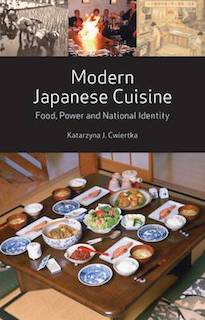Modern Japanese Cuisine:
Food, Power and National Identity Katarzyna J.
Cwiertka
Reaktion Books 2006

I read this in late July 2018. Japan is a country which is
obsessed with food, an obsession which is never more clearly shown
than the way food features in so many television programs, as
’tarento’ (celebrities) ‘make a meal of’ yet more ramen, chicken
karaage, beef…. However, the writer takes a much more insightful
look at Japanese food by looking at how Japan’s food culture has
developed since the Meiji Restoration. In particular, the writer
describes how influences from abroad were steadily absorbed and
adapted, with one channel being the use of Western food dishes in
military catering, with the main idea being to build up height and
weight. Ironically, in some ways, Western food, which was
initially unfamiliar to all recruits, was easier to offer than
staples such as miso soup, where tastes varied across the
country. However, as the book shows, initially, many
vegetables which are now the key to everyday dishes, were not
available, including onions and potatoes. Ichitaro Kanie, whose
family farmed near Nagoya, is one pioneer who is introduced.
Failing to successfully sell tomatoes, he moved to producing
tomato puree for early Western restaurants. Towards the end of the
book, the writer moves on to look at how Japanese food has in turn
been internationalized and adapted, with one example being
‘Wagamama’, the popular chain in Britain. In many ways that is far
from authentic, but, as the writer indicates, much which leads to
a traditional image of ‘Japanese food’ is relatively modern, and a
major change from its historical roots.
Another book related to Japan's food culture
Other books
